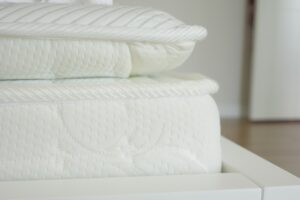We all understand how the mattress we choose can significantly influence our sleep quality, level of energy, and ability to focus during the day. However, due to the endless choice of sizes, materials, and types on the market, picking the best mattress for your needs can be challenging.
There are many different types of mattresses, and even types within those categories. For instance, within the foam category there is the cheap mattress, and the premium mattress; cheap mattresses are soft, but they sink without offering support; premium mattresses are also soft, but offer proper support without losing the comfort.
As we compare the differences between spring and foam mattresses, keep in mind that the premium foam mattresses are what we’ll be comparing against the spring mattress.
Sleep Position
We all sleep in different positions, and finding a mattress that supports your position, encourages comfort, and protects your spine’s health, is crucial.
Foam
If you sleep on your side, a foam mattress will conform well to the body’s curve, supporting your sleep position without forcing an unnatural bend or angle. As your hips and shoulders naturally sink further into the foam, the lighter parts of your body often stay aligned with the mattress’ surface.
This ensures that your spine maintains a healthy alignment. Firmer foam mattresses are suitable for stomach or back sleepers because they support the posture without interfering with breathing.
Spring
Because spring mattresses do not conform to the shape of your body, they tend to be good for stomach sleepers, but can lack the premium comfort usually found in foam mattresses. Back and side sleepers may find that spring mattresses do not have what it takes for reaching the support areas created by the curves in your body when lying down on your side or back. This can cause spinal misalignment and discomfort.
Firmness
The density of the mattress significantly influences your level of comfort it can offer you while asleep. Medium-firmness is a generally suitable option if you don’t know what mattress type is best for you.
Foam
Foam mattresses offer a medium-firmness level while providing ergonomic support and contouring to your natural body position and spine alignment. In terms of comfort, foam mattresses tend to be more comfortable, but if you require more support, more modern types of foams (such as memory foam) can offer you firmer options—and a suitable compromise.
Spring
Spring mattresses, due to the sturdier internal structure, are firmer and reliable. However, the increased level of support is often compromised by the lack of contouring and ergonomics.
Pressure-Relief
A mattress that enhances body weight distribution and pressure relief has benefits including decreased inflammation, reduced back pain, and increased comfort levels. Since this can vary from person to person, sometimes testing the mattress in person is the best way to find the answer you need.
Foam
Foam mattresses, providing contouring and ergonomics, allowing your body weight to be distributed evenly. Indeed, the foam will provide support to each body part, filling the gaps between your curves and protecting the natural curve of your spine. This type of mattress is recommendable if you are dealing with chronic pain, joint problems, arthritis, or fibromyalgia.
Spring
Spring coils won’t be as effective in distributing your weight evenly and will tend to bounce back, so if you suffer from joint pains, spring mattresses can increase pressure on these points, and worsen your symptoms.
Ventilation
Sleeping in a cool, ventilated environment has considerable health benefits, and temperature can significantly impact your overall sleep quality. A mattress that retains heat can make you feel much hotter overnight, compromising your sleep, so you want to get the right level of ventilation to sleep soundly.
Foam
Cheap foam mattresses, as mentioned at the beginning, use foams which claim to help you sleep cool, but quite often have diluted foam properties which do not actually work! On the other hand, mattresses like those sold at Tochta are assembled with premium gel memory foam with thousands of gel beads that wick heat away from the surface, making sure you are always sleeping at the optimal sleep temperature. So rather than sleep surrounded by captured heat, premium mattresses capture and disperse it for sleeping at your natural body temperature.
Spring
Since there is empty space between the coils, spring mattresses naturally provide ventilation, especially as you move on the mattress and cause old air to escape and fresh, cool air to enter the mattress’ internal structure.
Spinal Alignment
Spinal alignment is arguably the most important aspect when seeking restorative sleep, and a poor-quality mattress can worsen your backache and joint problems.
Foam
Foam mattresses are known for their contouring and support properties, which makes them beneficial in back pain. They can alleviate pain and inflammation by promoting the spine’s natural alignment.
Spring
Due to the firmer structure, spring mattresses can either worsen or improve back pain. Testing the mattress before purchase and checking whether it is suitable for your body type and sleep position is helpful.
Motion Isolation
If you share your bed (whether with a spouse, kids, or even a pet) motion isolation is a major factor to consider. Motion isolation refers to a mattress’s property to prevent the transfer of motion from one side of the bed to the other. So, a bed that can isolate motion will help you count on a good night’s sleep regardless of others’ movements in the bed.
Foam
Foam mattresses prevent motion transfer due to the high density of the structure’s material. If you like to share your bed with your partner or kids, a foam mattress will absorb any movements, ensuring that you can sleep undisturbed.
Spring
Springs are so interconnected that there is no motion isolation, unless you invest in isolated coils which helps reduce the motion.
Conclusion
You want to cater to the sleep your body needs, and the right foam mattress has the resources necessary to give you a sound and supported rest. Not only does foam support and contour the natural curve of your spine, but it can promote and protect your overall sleep-affected health.




